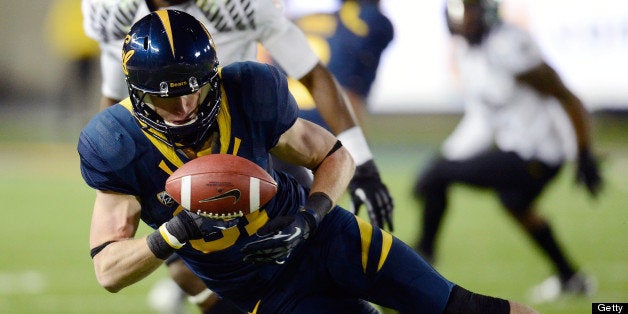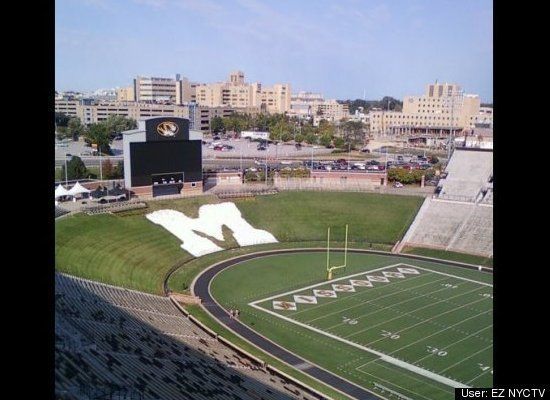
Cal's renovated football stadium and glistening new training center opened to rave reviews last fall, but the risky plan to pay for the facilities fared as poorly as the team itself.
The Bears hired a new coach to fix the on-field product. More important, they've implemented a new strategy to avoid fiscal calamity.
If the financing plan fails, the most expensive facility upgrades in college sports history -- the total cost is $474 million -- could cripple Cal athletics over time by draining tens of millions of dollars away from the operating budget.
"If it doesn't settle itself out in the next few months, I fear a disaster," said Stanford economist Roger Noll, an expert in stadium financing who has
consulted with Cal's faculty budget committee on the issue.
"They took a really big shot."
The Bears planned to finance the projects through the sale of 40- and 50-year rights to approximately 2,900 high-priced seats in the renovated stadium. But with sales lagging -- only 64 percent of the premium seats have been sold -- the school abandoned its June deadline to secure commitments for the long-term equivalent of $272 million.
The Bears are $120 million short of that goal.
"The thinking was that after the stadium was finished, once people could experience it, that there would be a big uptick in sales -- and that hasn't happened," said John Wilton, Cal's vice chancellor for finance. "It's a challenge."
Citing
public safety concerns, the University of California Regents directed the school to retrofit its 90-year-old stadium, which sits atop the Hayward Fault.
But the Bears spared no expense: In addition to the costs directly related to seismic improvements, they spent $250 million on the training center and stadium amenities -- more than Michigan, one of college football's blue bloods, doled out for a similar endeavor.
The plan to pay for the facilities was as risky as the projects were ambitious.
Cal financed the construction with $445 million in long-term bonds authorized by the Regents -- with the expectation that the athletic department would be responsible for servicing the debt.
To generate the cash, the Bears teamed with Stadium Capital Financing Group, a Chicago-based subsidiary of Morgan Stanley, to sell long-term rights to seats that cost as much as $225,000. In order to avoid appearing draconian, the university decided to allow purchasers to back out of their seat contracts at any time, with no penalty.
Stadium Capital Financing pitched its plan to other universities but had only one other known client. Kansas tried selling long-term rights to high-priced seats to fund a stadium renovation in 2009.
"It went poorly, and we're no longer doing it," associate athletic director Jim Marchiony said.
Cal officials blame bad timing for the lackluster sales: The financing plan was devised in 2007-08 and implemented during the heart of the recession. The football team's poor showing hasn't helped, either. In the past three seasons, the Bears are 15-22.
As a result, Cal currently has $55 million in the fund established to service the debt. That's not as much as it seems, given that the school owes $14.8 million next year and then at least $18 million annually until 2032. At that point, the principal kicks in and the payments soar to an average of more than $30 million.
"Clearly, initial seat sales goals were overly ambitious," athletic director Sandy Barbour said. "Why that was doesn't really matter. We needed to adjust."
(Cal paid Stadium Capital Financing $4.6 million, including expenses. A former company executive declined to comment on the situation. It's unclear whether SCF remains in business.)
The revised plan reduces Cal's reliance on selling high-priced tickets and attempts to generate $5 million to $10 million per year from previously untapped sources, such as renting out empty space in the stadium to the Haas School of Business.
But in a troubling sign, Cal officials have tentatively earmarked for long-term debt service more than $50 million that would otherwise have gone to athletic department operations over time.
Their revised financing plan includes $2.5 million annually in television money from the College Football Playoff, which begins in 2014, and millions more from the sale of local media sponsorships.
"What they're doing with the football playoff money is a bad sign," Noll said. "They're pulling from one pocket and putting into another.
"They have to accumulate a surplus and get enough money invested in order that the day of reckoning" -- when the principal payments kick in 2032 -- "doesn't wipe them out."
Barbour did not rule out the possibility of redirecting other revenue streams to stadium financing. One option could be a portion of Cal's share of the Pac-12 Conference's $3 billion television deal. Each school will receive an average of $20.8 million from Fox and ESPN over the life of the 12-year contract.
"Is it possible the adjustments will constrict our operating budget? Yeah," Barbour said. "And if it does, we'll address it at the time."
Said Wilton, the vice chancellor: "It puts more pressure on them, but so be it."
The situation could put the Bears at a competitive disadvantage: Many Pac-12 peers are likely to funnel TV revenue to football recruiting budgets and coaches' salaries and to support money-losing Olympic sports.
It's also a worrisome sign for a department that nearly cut four sports (and reclassify a fifth) in 2010 because of budget woes.
"We have a lot of faith in the people making the decisions," said baseball coach David Esquer, whose program was eliminated, then reinstated -- and is now self-funded. "I haven't sensed any behind-the-scenes discomfort."
The $50 million in long-term media revenue earmarked for stadium debt could have been put to another use: Reducing the athletic department's reliance on institutional support.
This year, the Bears received $4.5 million in campus funds, which come from a variety of sources, including student fees. (Taxpayer dollars are not used to support athletics.) The figure is expected to decrease to approximately $2 million starting next year.
Most major college athletic departments rely on some level of institutional support.
"It's a buffer," said chemical engineering professor Alexis Bell, who has been the faculty's liaison to athletics during the stadium renovation project. "But yes, we'd like to see it go to zero."
If the revised financing plan works, it would eliminate the need for athletics to redirect additional revenue to the stadium and relieve pressure on the operating budget.
To test the model, Wilton, the vice chancellor, asked three professors from the Haas Business School to perform a series of stress tests. The results were encouraging: With a 6 percent return on investment, the Bears won't run out of money until they have paid off the majority of the debt.
Then again, the model depends on years of steady ticket sales to a fan base that thus far has been reluctant to take the plunge.
The Haas team included in its accounting $12 million annually from premium seat sales. That's only slightly less than the Bears averaged before the ballyhooed unveiling of the renovated stadium.
"There's a lot of time, and that's important," said professor William Fuchs, a member of the Haas team. "But we don't vouch for the assumptions of revenue-generation provided by the athletic department. If they overestimated things, the model won't work."
For more on college sports, see Jon Wilner's College Hotline at blogs.mercurynews.com/collegesports. Contact him at jwilner@mercurynews.com or 408-920-5716.
--- ___
(c)2013 the San Jose Mercury News (San Jose, Calif.)
Visit the San Jose Mercury News (San Jose, Calif.) at www.mercurynews.com
Distributed by MCT Information Services
